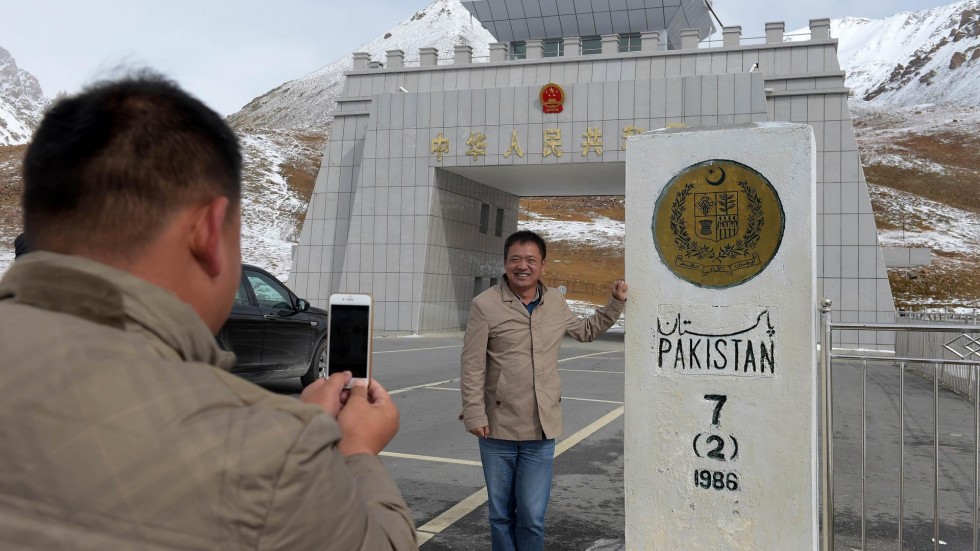Economic geology of CPEC: Part - II
The China-Pakistan Economic Corridor (CPEC) did not appear in a historical vacuum, but rather emerged from the womb of historical continuum. Building upon China’s historical connections with the Pakistani side of High Asia, the former in collaboration with the latter built the Karakoram Highway (KKH), which in turn paved the way for CPEC.
However, CPEC is different in terms of magnitude, coverage and purpose. The KKH was primarily driven by a geo-strategic and political agenda, whereas CPEC is a manifestation of the shift in China’s policy from geo-economic and economic geology.
The One Belt One Road (OBOR) initiative signifies increased connectivity and investment opportunities. Given the diversity of political systems, interests, geographies and economic models in the countries coming under OBOR’s ambit, a holistic and coherent policy is the need of the time.
Formulating a policy is essentially a political issue. It will be a Herculean task to bring diverse states on one page, but it can become a reality because the main factor that propels OBOR is economic and not ideological. Through OBOR and CPEC, China wants to increase its connectivity to international markets and energy sources. A common economic policy for the whole of OBOR, or even certain geographical parts, will prepare the ground for economic unification of the OBOR region. The second element of OBOR is currency. It may be possible to introduce a regional currency, like the Euro, in the region.
Given OBOR’s intricacies, CPEC’s planning needs to be such that harmonises discordant parts within a holistic framework that takes into consideration the contextual realities of Pakistan. To remove bottlenecks and obstacles for the smooth implementation of CPEC, the Pakistani government ought to introduce major structural changes in its political, economic and administrative domains. It will help Pakistan remove the contradictions in its current structure of governance, which is incongruous with CPEC’s requirements.
This is why the two countries are still working out ways to counter CPEC bottlenecks. To chalk-out implementation and financing mechanisms and processes, Pakistan needs to view CPEC at the local, national, regional and continental levels. There is a likelihood of CPEC being expanded beyond China and Pakistan. As per a report published in this newspaper on April 9, 2018, CPEC is being extended to Afghanistan.
At the national level, the major irritants in the implementation of CPEC stem from inequality in power-sharing among Pakistan’s federating units. For example, Balochistan being the largest province in terms of area, but smallest in population, has always remained at the receiving end. Similarly, Gilgit-Baltistan is not a constitutional part of Pakistan. The region’s ambiguous status and Pakistan’s flawed policies towards this region provide an excuse for non-CPEC actors to meddle in the country’s affairs by making CPEC controversial.
India has repeatedly been making claims over Gilgit-Baltistan, calling it disputed territory. Instead of addressing the ambiguities about this region, Pakistan keeps the status of Gilgit-Baltistan in a constitutional limbo. The status quo in this region may pose future challenges for Pakistan on the diplomatic front.
The tried and tested formula of Pakistani rulers with regard to internal dissent over CPEC is to first ignore those peripheral voices, and later offer them concessions when their opposition gets vehement. But these quick fixes cannot address CPEC’s challenges as they demand meticulous planning, nuanced understanding and empathetic handling of local issues. Only by taking into consideration the social and political dimensions from every angle can CPEC’s implementation become comprehensive and representative of local aspirations.
To envisage CPEC as a new paradigm of economy, Pakistan’s decision-makers have to take an imaginative leap. This would only be possible if they extricate their thinking from the confines of provincial and administrative boundaries, and economic paradigm of the pre-globalisation period. CPEC is to be viewed as a phenomenon which will blur administrative boundaries according to its needs and requirements. It will give birth to common economic interests with new social configurations. Hence, economic zones have to be established not on the basis of provinces but on geography.
For example, the social and economical dynamics of the coastal belt in Pakistan are different from its hinterland. To make CPEC more feasible, the coastal areas of Balochistan and Sindh can make one economic zone. The point where the northern tip of Sindh, north eastern Balochistan and southern Punjab converge can make an economic ring by forming a central economic zone. Similarly, the mountainous regions of Gilgit-Baltistan, Chitral, Kohistan and Swat in Khyber Pakhtunkhwa can be clubbed together under one economic zone.
Such an arrangement will enable the government to address issues pertaining to culture, identity, economy and environment, because the classification would be based on geographical anthropology and not on political or nationalist ideology. In the long run, the commonality of economic interests will give birth to new solidarities and associations, and help reduce politicisation of economic issues on the narrow basis of ethnicity.
In order to address local grievances, all the provinces, including the regions of Azad Kashmir and Gilgit-Baltistan, should be involved in CPEC planning at the centre, but its implementation can be devolved to the local level.
Among different regions of Pakistan, only Gilgit-Baltistan borders China – and the two have historical and cultural connections. Before coming under British suzerainty, the principality of Hunza had tributary relations with China. The region can benefit from this rich relationship by forging new synergies and taking initiatives on the cultural and economic fronts. China has turned Kashgar into a modern metropolis within two decades. Gilgit-Baltistan can learn from the development of the autonomous region of Xinjiang-Uighur. Because of the potential for carrying out mutual initiatives under the umbrella of CPEC, Gilgit-Baltistan can be envisaged as a case of hybrid development. If such a possibility emerges, the government of Gilgit-Baltistan will need to chalk-out a plan that would address issues pertaining to CPEC’s cross-border mode.
So far, the economic dimension has dominated discussions regarding CPEC at the expense of its knowledge dimension. The proposed corridor will not solely be economic, but will also serve as a knowledge corridor. Until recently, no research or information about CPEC was available. Due to lack of academic research on CPEC, the knowledge vacuum came to be filled by conspiracy theories. To stop this from further escalating into an anti-CPEC narrative, measures have to be taken to fill the information gap among the multiple stakeholders of CPEC.
China is attracting thousands of students for higher studies by providing scholarships. That will help China create a cadre of professionals who will have a better understanding of the Chinese mind, processes and knowledge. This is a highly laudable initiative. But there is another important aspect of China’s success in generating skilled and expert human resource – its school education system.
In Pakistan we have multiple schooling systems which have increased the class divide within society. Being an egalitarian education system, the Chinese schooling model can provide Pakistan with a viable model of education that can help bridge the yawning gap between the education for the haves and the have-nots.
During the last three years some universities and think tanks in Pakistan have established centres and special institutes to study CPEC. The available studies need to expand the horizon of the framework for research and encompass human and social dimensions. A purely quantitative and economic approach provides a skewed view of the intricate interface of simple social set ups and complex systems. In-depth studies of psychological, cultural, gender, cognitive and social dimensions of CPEC will provide us with insights of the dialectics of progress in the age of gigantic infrastructure.
Currently there is more talk related to CPEC than understanding. The physical pace of CPEC is taking giant leaps without leaving behind any trail of knowledge. If the knowledge vacuum is left open, it can become a good abode for conspiracies.
Concluded
The writer is a freelance columnist based in Gilgit.
Email: azizalidad@gmail.com
-
 Princess Irene's Coffin Arrives For Funeral Rites
Princess Irene's Coffin Arrives For Funeral Rites -
 Sean Penn's Gay Role Interview Resurfaces After LA Stroll With Valeria Nicov
Sean Penn's Gay Role Interview Resurfaces After LA Stroll With Valeria Nicov -
 FBI’s Most Wanted Caught After 10 Years In Mexico
FBI’s Most Wanted Caught After 10 Years In Mexico -
 Inside Kate Middleton's Meaningful Nod To Own Milestone
Inside Kate Middleton's Meaningful Nod To Own Milestone -
 Zachary Levi 'running' To Build His Future In Politics?
Zachary Levi 'running' To Build His Future In Politics? -
 Andrew Lands In Fresh Major Trouble After Princess Eugenie Left Him 'devastated'
Andrew Lands In Fresh Major Trouble After Princess Eugenie Left Him 'devastated' -
 Colleen Hoover Shares Major Update About Cancer Treatment
Colleen Hoover Shares Major Update About Cancer Treatment -
 UK Starmer Rules Out US Trade War, Calls For ‘calm Diplomacy’ Over Greenland
UK Starmer Rules Out US Trade War, Calls For ‘calm Diplomacy’ Over Greenland -
 Billy Bob Thornton Clears The Air About His Exit From 'Landman'
Billy Bob Thornton Clears The Air About His Exit From 'Landman' -
 DC Boss Gets Honest About Two New 'Batman' Films
DC Boss Gets Honest About Two New 'Batman' Films -
 Prince Harry Feels Sidelined By Meghan Markle As He Searches For Clearer Direction
Prince Harry Feels Sidelined By Meghan Markle As He Searches For Clearer Direction -
 Meghan Markle Warned About 'risky Move' As Prince Harry Arrives In Britain
Meghan Markle Warned About 'risky Move' As Prince Harry Arrives In Britain -
 Why Ashton Kutcher Is Still Talking About Whether He Showers
Why Ashton Kutcher Is Still Talking About Whether He Showers -
 IMF’s World Economic Outlook: ‘Resilient’ 2026 Growth Expected Amid Tariffs & AI Boom
IMF’s World Economic Outlook: ‘Resilient’ 2026 Growth Expected Amid Tariffs & AI Boom -
 Find Out Early Subtle Signs That You Might Have Parkinson's Disease
Find Out Early Subtle Signs That You Might Have Parkinson's Disease -
 Prince Harry Appears In High Spirits, Greets Supporters At London High Court
Prince Harry Appears In High Spirits, Greets Supporters At London High Court




